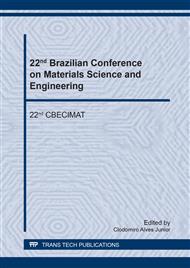p.454
p.460
p.466
p.472
p.478
p.484
p.489
p.495
p.501
Ellipsometric Characterization of AZ31 Magnesium Alloy
Abstract:
Ellipsometry is a non-destructive and indirect technique able to characterize both optical and dielectric properties of thin films and bulks, besides determining the thickness of thin films. This characterization is performed by evaluating the change in the polarization state of the incident light when it interacts with the material of interest. In this work, the ellipsometry technique was used to characterize optical properties of AZ31 magnesium alloy samples. This alloy has several interesting properties such as low density, high thermal conductivity, good machinability, among others, which makes it suitable for use in automotive and aerospace components. However, when this alloy is exposed to ambient atmosphere, it undergoes natural oxidation, developing a surface film of oxides and/or hydroxides. This study aimed to establish an efficient methodology for accessing the optical and dielectric characteristics of the substrate (AZ31 alloy) as well as those for the surface film of oxide/hydroxides, and to obtain the thickness of this film. Four samples mechanically grinded and polished were investigated: One sample, namely P sample, was subjected to the ellipsometric measurements immediately after grinding and polishing and three samples, namely A10, A50 and A60, were exposed to the air at 150°C during 10, 50 e 60 minutes, respectively. From the results of the ellipsometric measurements for P sample, it was possible to determine the refractive index (n) and extinction coefficient (k) curves as a function of the wavelength (λ) for the substrate (AZ31 alloy). Besides, through appropriate modeling, it was possible to determine the thicknesses of the oxides/hydroxides films presented in A10, A50 and A60 samples. The thicknesses values obtained seem to be quite coherent when we analyze the surface roughness of these samples using the confocal microscope, validating the optical model constructed to represent the A10, A50 and A60 samples. The results achieved in this study can contribute to the study of both of oxides/hydroxides layers growth and protective coating films growth for AZ31 magnesium alloy.
Info:
Periodical:
Pages:
478-483
Citation:
Online since:
September 2018
Price:
Сopyright:
© 2018 Trans Tech Publications Ltd. All Rights Reserved
Share:
Citation:


